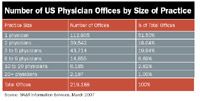Sales Management: Cleaning House
Pharmaceutical Executive
With fewer feet on the street because of downsizing at many drug firms, sales reps and managers need to work smarter-and that means working with information that's both accurate and up to date
Unlike a bottle of wine, a physician database does not improve with age. In fact, valuable medical information deteriorates at a rate of nearly 18 percent each year. Let's put this in terms of dollars. If you have the names and addresses of 100,000 physicians, and your database has not been updated in two years, then approximately 36,000 of those contact records are likely to be spoiled. If you mail a promotional piece that cost $3 each for printing and postage, you've just wasted $108,000 of your precious marketing budget.

Jack Schember
Bad data costs enterprises more than $6 billion a year, according to The Data Warehouse Institute. On the other hand, companies that implement data-quality initiatives add millions to their bottom line from increased sales, lower distribution costs, and better adherence to compliance regulations.
For the pharmaceutical industry, the need for clean data is more critical than ever. With fewer feet on the street following recently announced downsizing, pharmaceutical sales reps and managers need to work smarter, and that means working with information that is accurate and up to date. Understanding not just physicians but which medical groups they are part of, where they practice, what they practice, and who is among their support team, helps sales forces operate more effectively.
A Process for Validation
The process for data cleansing and augmentation can be described in four steps. First, match your database against an accurate data source to validate what you have and append missing marketing information or additional contacts. Appends may include phone, fax, e-mail, job titles, specialties, prescribing history, group affiliations, and other targeting intelligence. Next, match the data against a database of closed medical practices, inactive doctors, or doctors not likely present at a valid site. Third, get updated addresses through a change-of-address service provider. Finally, resolve troublesome records through phone verification, Web research, or provider directories.
When the data is refreshed you have a more complete view of your market and thus can increase your opportunities for success. Here's what a verified and augmented database enables you to accomplish:

Number of US Physician Offices by Size of Practice
Understand the business environment in which physicians work Physicians delegate to other prescribers such as nurse practitioners and physician assistants. They rely heavily on support personnel like office managers and practice administrators. These are the gatekeepers who can facilitate appointments and product-detailing efforts. All of these contacts must be accurately maintained.
Expand marketing to the group level A sales rep's most important contacts are at the group practice level. It's not enough to see just one physician, but have the ability to link physicians to their group practice site or sites. This is where some of the biggest and best opportunities can be uncovered. A database should reflect the full view of the practice. Can you link physicians to their sites, link multiple sites to a group headquarters, and identify the executives for the group practice? Can you link physicians and groups to hospital affiliations, independent physician associations, or health systems? A database that ties all these important entities together is an ideal asset.
Reach physicians where they make business decisions Accurate business address, phone, and fax is the critical foundation for effective sales-call activity. Delivering your message to the business address also means you are more likely to influence a practitioner, and not an academic or researcher. Targeting prescribers is of little value if all you have is their home address.
Adhere to governance and regulations State license numbers, DEA numbers, UPINs and, coming soon, the National Provider Identifier, are necessary identifiers that must correlate accurately to the proper physicians to satisfy corporate and government compliance, billing, and insurance.
Half-Good is Not Good Enough
Let's say a pharmaceutical company submitted its database of 140,000 physicians to a data-verification center that offered a source database of 617,000 practicing physicians; it is telephone-verified every six months and is often used in the industry for matching and appending.
Comparing its database against the verifier's, the pharmaceutical company found that 45 percent of its names were valid and correct, 34 percent were corrected with a simple address change, 14 percent were invalid because the physician had either retired or was deceased, and 7 percent were likely invalid records because they could not be verified. In the end, 93 percent of the pharmaceutical company's database was resolved. Had it not taken this initiative, the pharmaceutical company would have been working with data that was less than 50 percent accurate.

Find the Right Targets
Weigh the Costs
Without updating their data assets at regular intervals, pharmaceutical companies risk wasting thousands of dollars in missed appointments, undeliverable mail, and low telephone connects. Even more expensive are the missed opportunities because a message didn't get through to a qualified decision maker.
The benefits far outweigh the costs. In fact, the cost of a data-hygiene service can be recaptured after just one sales or marketing event. A scrubbed database enables you to send information that is more relevant, put sales reps on the right course, improve office relationships, make smarter decisions about segmenting, and contribute positively to the bottom line.
Jack Schember is director of marketing at SK&A Information Services. He can be reached at jack@skainfo.com

Addressing Disparities in Psoriasis Trials: Takeda's Strategies for Inclusivity in Clinical Research
April 14th 2025LaShell Robinson, Head of Global Feasibility and Trial Equity at Takeda, speaks about the company's strategies to engage patients in underrepresented populations in its phase III psoriasis trials.
Beyond the Prescription: Pharma's Role in Digital Health Conversations
April 1st 2025Join us for an insightful conversation with Jennifer Harakal, Head of Regulatory Affairs at Canopy Life Sciences, as we unpack the evolving intersection of social media and healthcare decisions. Discover how pharmaceutical companies can navigate regulatory challenges while meaningfully engaging with consumers in digital spaces. Jennifer shares expert strategies for responsible marketing, working with influencers, and creating educational content that bridges the gap between patients and healthcare providers. A must-listen for pharma marketers looking to build trust and compliance in today's social media landscape.